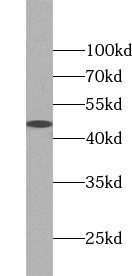Products
SERPINH1 antibody
| Synonyms: | Serpin H1|47 kDa heat shock protein|Arsenic-transactivated protein 3 (AsTP3)|Cell proliferation-inducing gene 14 protein|Collagen-binding protein (Colligin)|Rheumatoid arthritis-related antigen RA-A47|SERPINH1|CBP1|CBP2|HSP47|SERPINH2 antibody | ||
| Catalogue No.: | FNab04045 | Reactivity: | Human, Mouse |
| Host: | Rabbit | Tested Application: | ELISA, IHC, WB, IF |
| Clonality: | polyclonal | Isotype: | IgG |
| Size | Price |
|---|---|
| 100µg | Inquiry |
- SPECIFICATIONS
- FIGURES
- CONDITIONS
- FAQS
- Product Name
- SERPINH1 antibody
- Catalogue No.
- FNab04045
- Size
- 100μg
- Form
- liquid
- Purification
- Immunogen affinity purified
- Purity
- ≥95% as determined by SDS-PAGE
- Clonality
- polyclonal
- Isotype
- IgG
- Storage
- PBS with 0.02% sodium azide and 50% glycerol pH 7.3, -20℃ for 12 months (Avoid repeated freeze / thaw cycles.)
- Immunogen
- serpin peptidase inhibitor, clade H (heat shock protein 47), member 1, (collagen binding protein 1)
- Alternative Names
- Serpin H1|47 kDa heat shock protein|Arsenic-transactivated protein 3 (AsTP3)|Cell proliferation-inducing gene 14 protein|Collagen-binding protein (Colligin)|Rheumatoid arthritis-related antigen RA-A47|SERPINH1|CBP1|CBP2|HSP47|SERPINH2 antibody
- UniProt ID
- P50454
- Observed MW
- Refer to figures
- Tested Applications
- ELISA, IHC, WB, IF
- Recommended dilution
- WB: 1:500 - 1:2000; IHC: 1:50 - 1:200; IF: 1:50 - 1:200
 HT-1080 cells were subjected to SDS PAGE followed by western blot with FNab04045(SERPINH1 antibody) at dilution of 1:1000
HT-1080 cells were subjected to SDS PAGE followed by western blot with FNab04045(SERPINH1 antibody) at dilution of 1:1000
 Immunohistochemistry of paraffin-embedded human hepatocirrhosis tissue slide using FNab04045( SERPINH1 Antibody) at dilution of 1:50
Immunohistochemistry of paraffin-embedded human hepatocirrhosis tissue slide using FNab04045( SERPINH1 Antibody) at dilution of 1:50
 Immunofluorescent analysis of HeLa cells using FNab04045( SERPINH1 Antibody) at dilution of 1:25 and Alexa Fluor 488-conjugated Goat Anti-Rabbit IgG(H+L)
Immunofluorescent analysis of HeLa cells using FNab04045( SERPINH1 Antibody) at dilution of 1:25 and Alexa Fluor 488-conjugated Goat Anti-Rabbit IgG(H+L)
- Background
- This gene encodes a member of the serpin superfamily of serine proteinase inhibitors. The encoded protein is localized to the endoplasmic reticulum and plays a role in collagen biosynthesis as a collagen-specific molecular chaperone. Autoantibodies to the encoded protein have been found in patients with rheumatoid arthritis. Expression of this gene may be a marker for cancer, and nucleotide polymorphisms in this gene may be associated with preterm birth caused by preterm premature rupture of membranes. Alternatively spliced transcript variants have been observed for this gene, and a pseudogene of this gene is located on the short arm of chromosome 9.
How many times can antibodies be recycled?
First, usually it's not suggested to recycle antibodies. After use, buffer system of antibodies has changed. The storage condition of recycled antibodies for different customers also varies. Thus, the performance efficiency of recycled antibodies can’t be guaranteed. Besides, FineTest ever conducted the antibody recycling assay. Assay results show recycling times of different antibodies also varies. Usually, higher antibody titer allows more repeated use. Customers can determine based on experimental requirements.
Notes: After incubation, we recycle rest antibodies to centrifuge tube and store at 4℃. High titer antibodies can be stored for a minimum of one week. Reuse about three times.
What are components of FineTest antibody buffer?
Components of FineTest antibody buffer are usually PBS with proclin300 or sodium azide, BSA, 50% glycerol. Common preservative is proclin300 or sodium azide, which is widely applied in the lab and industry.
How about the storage temperature and duration of FineTest antibodies?
Most antibodies are stored at -20℃. Directly-labeled flow cytometry antibodies should be stored at 2 - 8℃. The shelf life is one year. If after sales issues for purchased antibodies appear, return or replacement is available. Usually, antibodies can be still used after the one-year warranty. We can offer technical support services.
Is dilution required for FineTest antibodies? What’s the dilute solution?
Directly-labeled flow cytometry antibodies are ready-to-use without dilution. Other antibodies are usually concentrated. Follow the dilution ratio suggested in the manual. Dilute solution for different experiments also varies. Common antibody dilution buffers are acceptable(e.g. PBST, TBST, antibody blocking buffer).
How to retrieve antibodies for immunohistochemistry?
Common retrieval buffers: Tris-EDTA Buffer(pH 9.0); Citrate Buffer(pH 6.0)
Heat induced antibody retrieval:
Method 1: Water-bath heating: Put the beaker with retrieval buffer and slide in the boiling water bath. Keep the boiling state for 15min. Naturally cool to room temperature;
Method 2: Microwave retrieval: Put the beaker with retrieval buffer and slide in the microwave oven. Heat at high power for 5min, Switch OFF for 3min, Heat at medium power for 5min. Naturally cool to room temperature.
How to choose secondary antibodies?
(1) Secondary antibodies react with primary antibodies. Thus, secondary antibodies should be against host species of primary antibodies. E.g. If the primary antibody is derived from rabbit, the relevant secondary antibody should be against rabbit. E.g. goat anti rabbit or donkey anti rabbit.
(2) Choose secondary antibody conjugates according to the experimental type, e.g. ELISA, WB, IHC etc. Common enzyme conjugated secondary antibodies are labelled by HRP, AP etc. Fluorescin or dye labelled secondary antibodies are applied in immunofluorescence and flow cytometry(e.g. FITC, Cy3).
